Keramat Kallang
Legends and Myths
Written by Urban Explorers of Singapore | Know more about UESG | Go Facebook With Us
Pseudo-keramats were once a ‘trend’ in Singapore during the mid-twentieth century, as often people of different races would visit ‘sacred’ tombs, to donate prayers or offerings for the deceased. Just a voice for a devotee or the caretaker, to say that the tomb able to produce miracles will change the entire space into rows of people waiting for their turn to ‘ask’ something from the dead. This enigma seen many years ago at Keramat Iskandar Shah or Keramat Merpati once found along Bukit Timah road.
Keramat Kallang was one of the most recent sites that were noted as pseudo-keramat. As much as one should not defy people’s beliefs, it’s not wrong to question the myths that sprouted from keramat sites.
It was in 2005 when a claim of a 300-year-old grave from Kallang started. The post was originally from Singapore Paranormal Investigators (SPI) forum, described that it belongs to a pious lady name Siti Mariam.
“Was this claim authentic?”
It was after hearing the name Tok Putih and Tok Hitam in 2007 that the team started focusing on the subject. The first impression was that they were rivals; assumptions based on the color opposite given to them – Putih (Malay for White) is contrary to Hitam (Malay for Black).
According to hearsays, Zad (not real name), explained that the two men were berilmu. In English, ilmu means knowledge, therefore berilmu means knowledgeable. However, to some Malay’s views, berilmu means a person with ‘supernatural powers’. Zad then added that the name Tok Putih was because he’s berilmu using religion (or agama) while Tok Hitam uses spiritual (or Batin). Indirectly claiming that religion is ‘light’ and spiritual is ‘dark’.
I’ve suggested that to uncover the facts, we need to locate their tombs and interview the caretaker, or someone, that knows about the history. After discovering via online search that the tombs were keramats and located near the so-called 300-year-old-tomb, with an attempt to slingshot twin birds with a stone, the team sets out one evening for a visit.
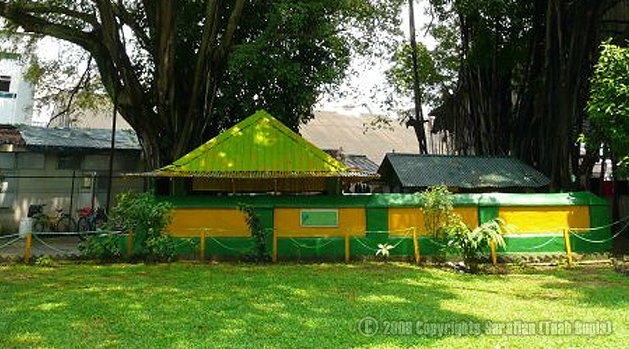
Courtesy of Sarafian (Tuah Bugis)
The visit was to learn more about Tok Putih and Tok Hitam, and also to unravel the truth of the so-called 300-year-old tomb. The direction was to interview the caretaker who maintained the site, because, from observations, they knew more in details. However, one also needs to consider that not everything shared was logically valid.
We reached the site pretty late. It was already after 10.00pm, and the caretaker was already asleep.
There was this Malay man claiming as a close friend to the caretaker. Introductions and random chatter began about Keramat Kallang. He then offered a short ‘tour’ into the grave compound.
Later, after exiting, while standing by the curb of the Stadium Link road, the man began with storytelling. There were few questionable notions.
- That tomb described as 300 years old, what’s the date written on its tombstone?
- This Istana Kallang gossiped to exist before Sang Nila Utama arrival. Who’s the ruler that lived in this istana? Any names?
- Headstone inscriptions were ‘ancient Jawi’ and professional researcher or investigators have failed to translate them. Did they come back to inform that they’ve failed?
- Those buried were descendants of Ibrahim, a prophet and apostle of God. Is there any silsilah (genealogy) reference to support the facts?
- The ‘snake guardian’ that guarded the tombs is still alive after cements filled its burrow, and waiting for a chance to get out. If it cannot get out, and nobody seen it outside the cemented burrow, then how does one know it still breathing?
The inquiries remain unanswered. The man recommended to drop by during the day and ask his friend, the caretaker. Left after thanking the Malay man, the team then marched towards the site of the 300-year-old tomb. Did not lingers at Siti Mariam site because someone was sleeping underneath the roof. The trip ended after speculating the murk with torches switch off, and loitering in the area.
Few revisits were made during the day, hoping to acquire some answers, however, the recommended caretaker could not provide any. There wasn’t any opportunity to discourse with Mohamed bin Hassan (also known as Wak Ali, Tok Ali, Pak Ali and Pak Ali Janggut), as he’s constantly engaged with someone. He has maintained Keramat Kallang over 20 years and also officially recognized as the caretaker. If there were opportunities to speak with him, this report could have been issued in 2008.
The inquiry’s remain unanswered until 2013.
The objective of this report was to validate the claims, as well as to research the brief history of the late. The direction has evermore firm, and that is to elicit fictions, omit nothing but facts.
Table of Contents
- A Trader Family from al-Aydrus cemetery
- Light and Dark of al-Qadri cemetery
- Istana Kallang, debunked
- Guardian Snake, debunked
- Exhumation Halt, debunked
- Mysterious Graves at Chua Chu Kang cemetery
- Notes
- References
Do note that from this point onwards, the names will be according to what’s inscribed on their tombstone. The objective is for readers to aware of their actual names, and not the ‘popular names’ invented through time.
A Trader Family from al-Aydrus cemetery
They were a Hadhramis family from Hadhramaut, Yemen. Syed Abu Bakar al-Aydrus works as a trader, then married Sharifah Maimunah. She later gave birth to firstborn Sharifah Maryamin Hadhramaut, followed by Syed Abdullah and lastly, Sharifah Khadijah. They migrated to Pelembang before migrating to Singapore (after Sir Stamford Raffles’ arrival).
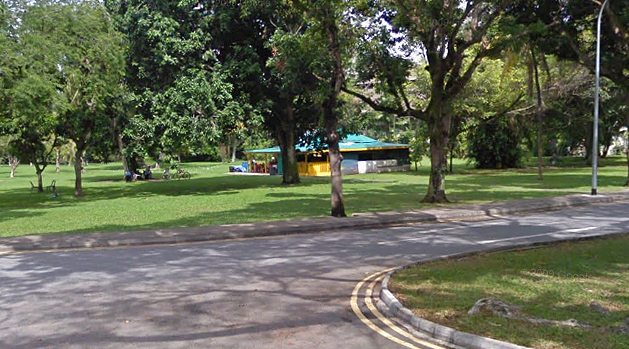
Corresponding to Berita Harian article printed on 10th December 1987, headlined “Usaha minta kekalkan Makam Siti Mariam” or in English, “Effort taken to preserve Siti Mariam Tomb”, it composed that the tomb believed to exist since 1589. It cannot be valid because her date of death recorded on the tombstone was 1852.
Her date of birth was not on it. It was controversial that Sharifah Maryam passed away in her 20s. With a grain of salt, she could have born within 1823 and 1831. Since there couldn’t be any evidence, it is only safe to conclude that she’s born in the early 1800s.
At this point, the facts established that rumors about Sharifah Maryam tomb being 300 years old, was not true.
As notified earlier, names in this report will be based on the tombstone inscription. Therefore, one has to wonder why sources, including Berita Harian, spelled Sharifah Maryam as Siti Mariam instead?
While Maryam to Mariam significantly shows an evolution of Malay language, like Ayer to Air (Malay for Water) or Chikgu to Cikgu (Malay for Teacher), the term Siti is short for Saiyidati, an Arab term for Miss and regularly use for family (or Ahl al-Bayṫ) of Rasulullah S.A.W.
Berita Harian article from 16th October 1999 spelled her name, as Hajah Siti Mariam. With the given explanations for ‘Siti Mariam’, the title Hajah, which only obtainable through pilgrimage, could be added intentionally because of mentioned that she was a pious lady. This suggestion is only theoretical.
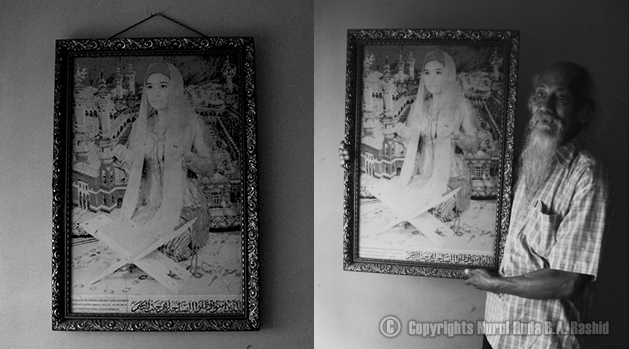
Courtesy of Nurul Huda B.A. Rashid
Extracted from Sharikqah LiveJournal, it wrote, “In the caretaker’s words, he used that photograph to symbolize who the saint was.”
It is accurate because it was not Sharifah Maryam, but a calendar model for August 1987.
“I also thought it was a photo of Sharifah Maryam at first. When I looked closer, there’s Arabic phrases at the bottom, followed by dates and the word Ogos 1987. The photo frame is new. Wak Ali and myself brought it to Bedok Central and have the frame renewed.” said Mr. Ridhwan.
The photo was by Ms. Nurul, taken during her visit on 10th January 2010, with her other colleague from the National University of Singapore (NUS). They were the last group to come and salvage items from al-Aydrus cemetery. An exhibition at NUS that took place from 13th January 2011 till 02nd December 2011 were to showcase the collected materials.
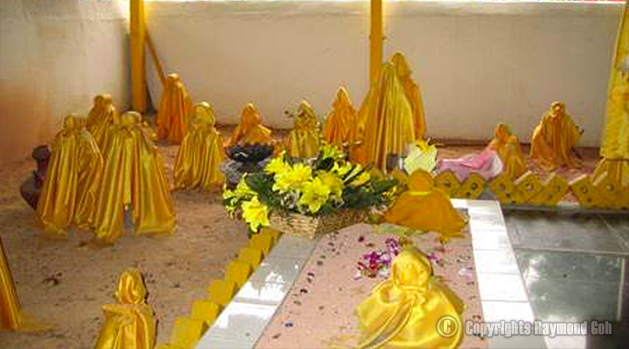
Courtesy of Raymond Goh
Extracted from Asia Paranormal Investigator (API) forum, it’s described that the middle tomb belongs to Syed Abu Bakar al-Aydrus, but this is incorrect.
It’s Sharifah Maimunah grave, wife of Syed Abu Bakar al-Aydrus. The other graves, a total of 17, were relative. Shown below is a closer view of her grave taken a few years later.
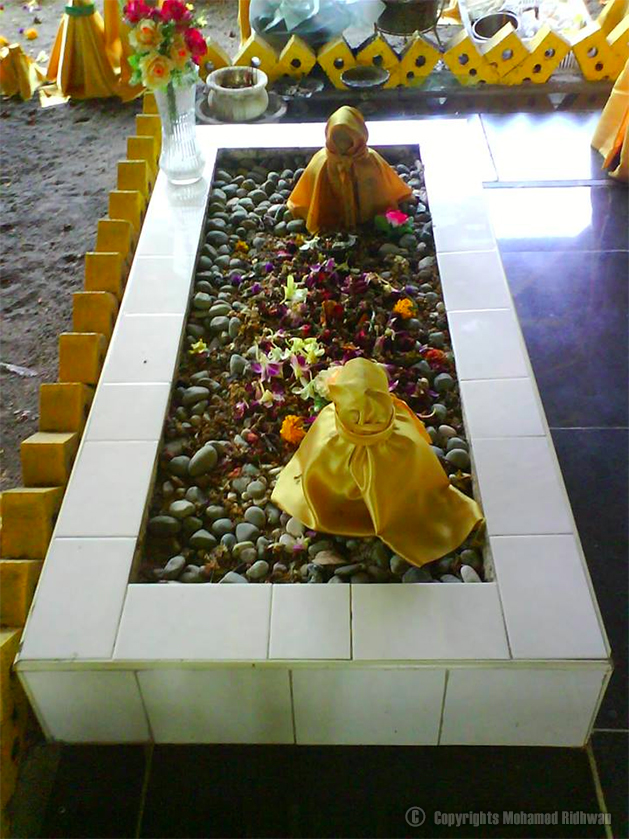
Courtesy of Mohamad Ridhwan
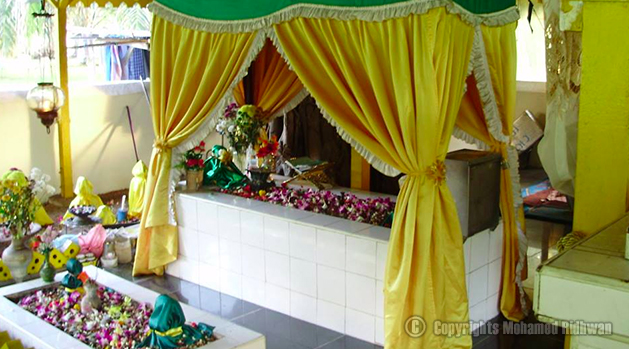
Courtesy of Mohamad Ridhwan
Sharifah Maryam grave was right next to her mother (above). Further right of Sharifah Maryam, opposite an old tree, was Sharifah Khadijah grave (below).
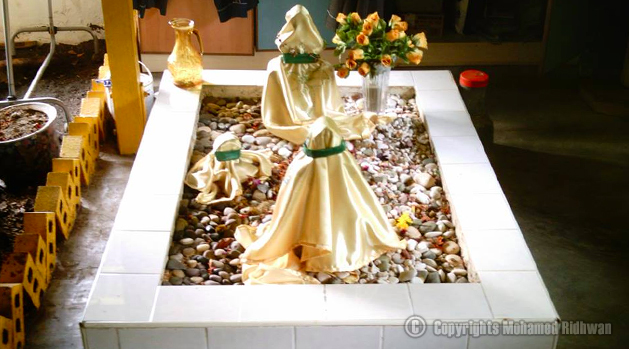
Courtesy of Mohamad Ridhwan
Only the female members of Syed Abu Bakar al-Aydrus family were with white tiles. The father, Syed Abu Bakar al-Aydrus, and the son, Syed Abdullah was buried behind the tree, facing the multiple hanging clothes displayed left of the cabinet (bottom).
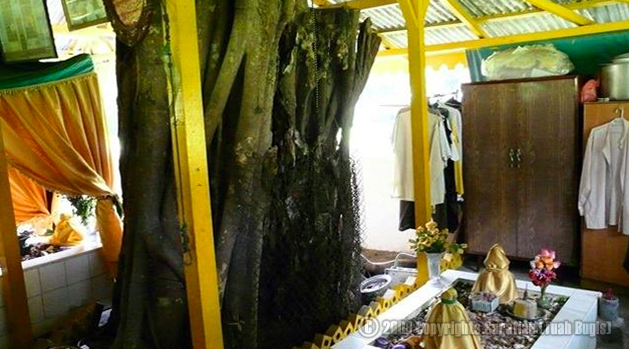
Courtesy of Sarafian (Tuah Bugis)
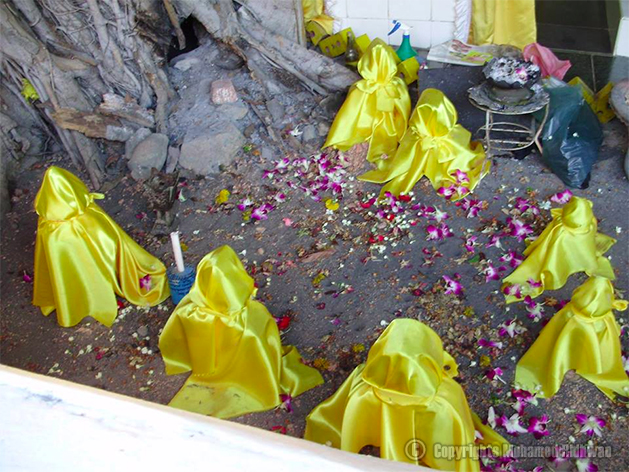
Courtesy of Mohamad Ridhwan
There were four graves as shown in the above photo. From the left was Syed Abu Bakar al-Aydrus followed his son, Syed Abdullah. The two other graves remained unidentified.
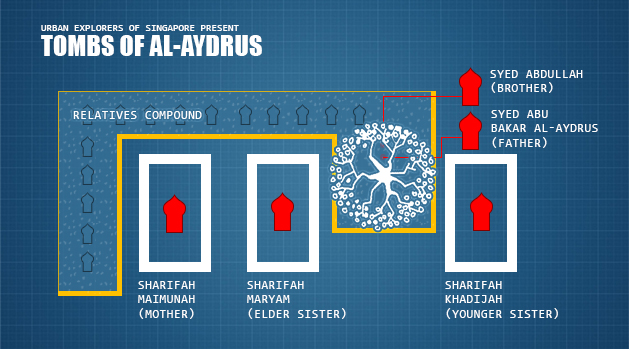
A total of 22 graves was exhumed on 21st September 2010, including the five keramats in al-Aydrus cemetery, which were the five family members of Syed Abu Bakar al-Aydrus.
Light and Dark of al-Qadri cemetery
Just like the family of Syed Abu Bakar al-Aydrus, the two men known as Sayyid Abdul Rahman al-Qadri (Tok Putih) and Sayyid Abdullah al-Qadri (Tok Hitam) were also Hadhramis, born in Hadhramaut, Yemen.
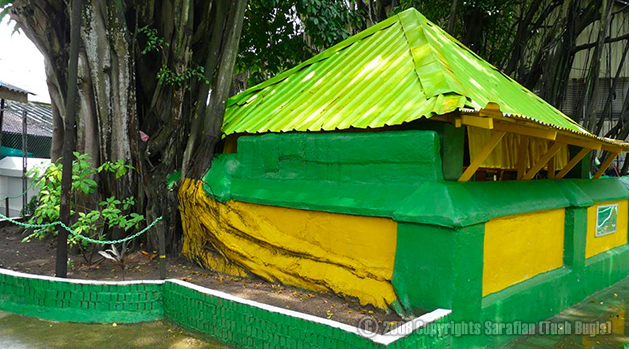
Courtesy of Sarafian (Tuah Bugis)
They were from the al-Qadri family, and their distance ancestor was Syarif Abdur Rahman al-Qadri, the first Sultan of Pontianak, West Kalimantan, Indonesia. It’s believed that al-Qadri was descendants of Prophet Muhammad S.A.W, and Prophet Muhammad S.A.W was a descendant of Prophet Ibrahim AS.
When the two men started their journey to preach Islam in Southeast Asia, they migrated to Pelembang before continuing their journey to Pontianak. During the reign of Sultan Syarif Usman al-Qadri, they then migrated to Singapore. Note that Tok Putih did not visit Aceh, Siak or Negeri Sembilan and Tok Hitam did visit Bogor, Sulawesi or Negri Sembilan.
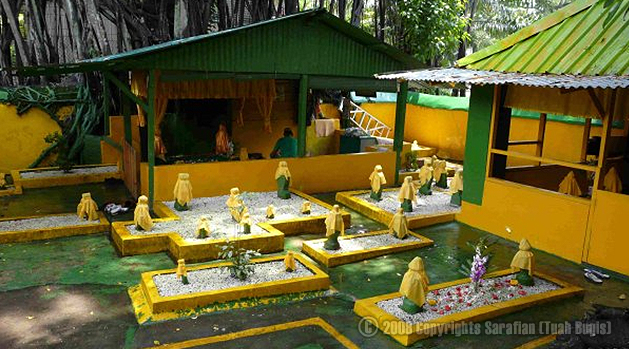
Courtesy of Sarafian (Tuah Bugis)
Various online references claim that both men were either Panglima (Commander) or Pengulu (Chief), however, this could be a misidentification.
The alias Tok Putih and Tok Hitam was common during the yesteryears. In Pasir Panjang, there existed two people with the alias Tok Hitam. One lived near the Pasir Panjang Police Station while the other lived near Sungai Bangkong (now part of West Coast Highway). There were hearsays about a man from a village in Pulau Belakang Mati, with the alias Tok Putih.
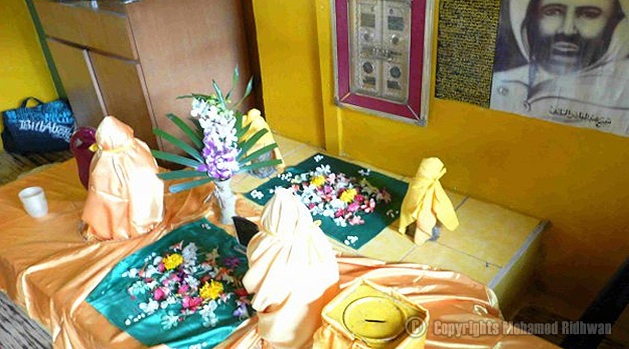
Courtesy of Sarafian (Tuah Bugis)
Was it true that the two men were Silat guru for the nearby Bugis villagers? When the Arabs migrated to Southeast Asia, some indeed learn Silat, especially those in Java. Descendant families noted to know Silat were al-Qadri, al-Shahab, al-Yahya and a few others. There are possibilities that Kampung Bugis villagers learn Silat from them, but the higher recognition goes to preaching Islam.
The biggest question that most would want to know is how the identity Tok Putih and Tok Hitam came about. It was because Sayyid Abdul Rahman al-Qadri has a lighter skin tone while Sayyid Abdullah al-Qadri was slightly darker.
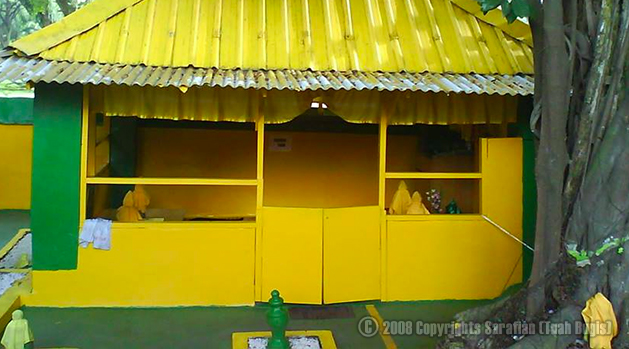
Courtesy of Sarafian (Tuah Bugis)
Both men passed away in circa 1820s and buried next to each other. In the hut, Tok Hitam was by the left while on the right was Tok Putih.
In 11th January 2010, a total of 23 graves exhumed, and there were only 2 keramats.
Istana Kallang, Debunked
Being said that Istana Kallang once existed in the area, before Sang Nila Utama’s arrival, could probably open up a new unwritten chapter in Singapura/Temasek history. I’ve checked both Malay Annals (Sejarah Melayu) translation from C. C. Brown and John Leyden, but there weren’t any mention of Kallang.
Assuming that it could be a Pengulu (Chief) house with a majestically grand look, but Mr. Ridhwan clarified that the building does not exist. Interviews with few Malay elders whom grew up in Kallang mentioned that they have not heard about it before.
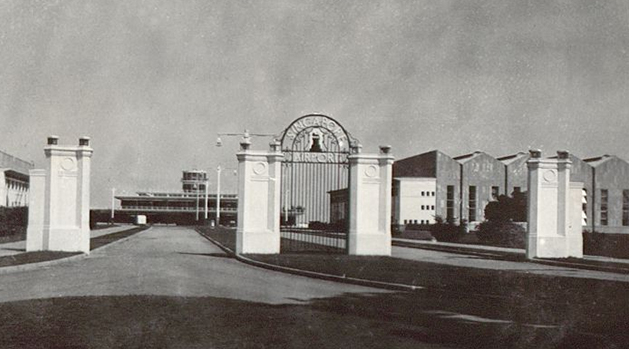
Courtesy of National Archives of Singapore
The origin of Istana Kallang refers to the old Kallang civil airport gateway known to some as ‘Gerbang Besar’ or ‘Large Gate’.
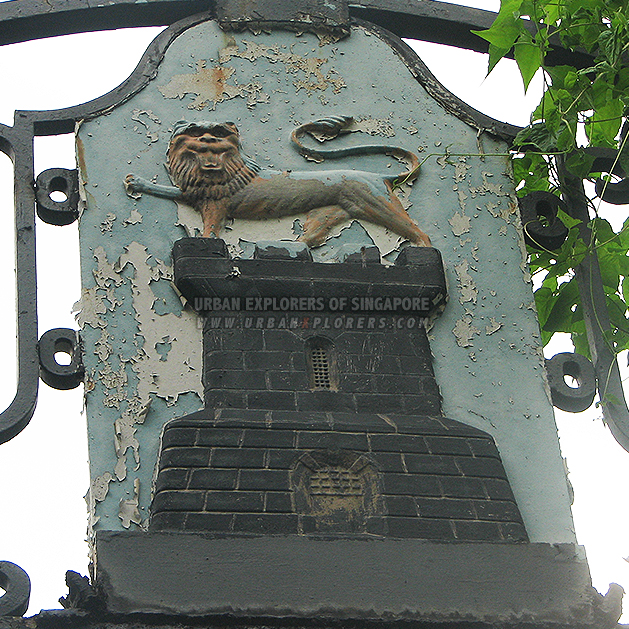
The key to concluding this mystery was because of the word Istana. It is both Malay and Indonesian word for Palace, but how many knows that it is also translated to Castle. As a conclusion, Coat of arms significantly shows an istana, located at the gateway.
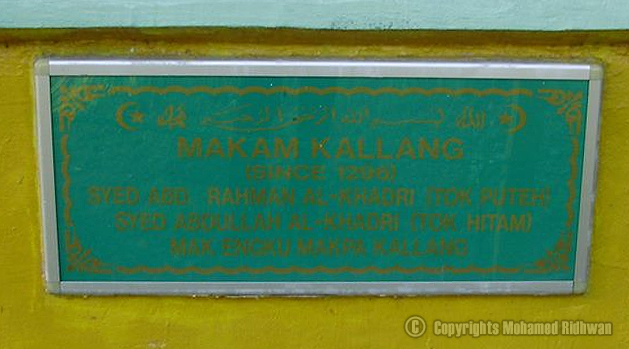
Courtesy of Mohamad Ridhwan
The ‘istana-before-Sang-Nila-Utama-arrival’ refers to this plaque. Do apologize for the image quality. I’ve written it down for a clearer reference.
MAKAM KALLANG
SINCE 1296
SYED ABD RAHMAN AL-KHADRI (TOK PUTEH)
SYED ABDULLAH AL-KHADRI (TOK HITAM)
MAK ENGKU MAKPA KALLANG
The year 1296 is Hijri format, and when converted to Gregorian, it’s 1879. This year was Shaykh Husayn al-Qadri year of death and one of the many buried at al-Qadri cemetery.
The Al-Qadri cemetery was not from 1879 (Gregorian) or 1296 (Hijri). It should be further back because the two keramats were c. 1820s (Gregorian) or c. 1230s (Hijri).
Digging deeper into the case, the so-called Istana Kallang was one of the semi-fictions from Wak Osman. It’s revealed that he’s not a caretaker neither appointed, or approval by Wak Ali. The person originally appointed as caretaker was Pak Yusof Arab. Wak Osman technically claims the site and self-proclaimed himself as a caretaker. Since then, numerous myths, including the 300-year-old tomb of Sharifah Maryam, started to develop.
Guardian Snake, Debunked
Another semi-fictional rumor made by Wak Osman was the so-called ‘Guardian Snake’ of al-Qadri cemetery. Even though there was a snake in the area, for it to be a ‘guardian’ was to each and his own belief.
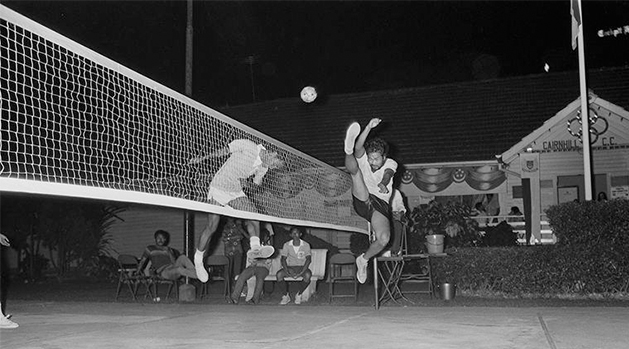
Courtesy of National Archives of Singapore
There were few old trees near the Sri Kallang takraw court where Firestone Rubber Company once located. One of them had a yellow cloth tied around it, often mistaken for ‘holy trees’ commonly seen in various part of Singapore. This yellow cloth served as an indicator, where the burrow was. It’s stated that this snake was old and lazy because it’s always stays in its hole, but sometimes, it took a quick peek outside before going into hiding again.
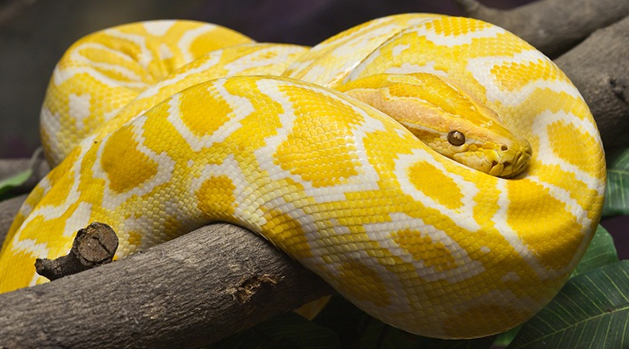
The color of the snake’s scale was described to be yellowish and whitish. The reptile was later identified as an Albino Burmese Python (Python bivittatus) with an approximate length of 1.2 meters. The creature also known as “The Golden Python”.
In September 2010 after the exhumations, old trees were being chopped. When the authority discovered about the python existence, they called forth an animal specialist for assistance. It is uncertain if those specialists were from the Animal Concerns Research & Education Society (ACRES). The python was still alive when the two men in black t-shirt recovered it, but nobody knows what happened after it goes into the sack.
Exhumation Halt, Debunked
Berita Harian “Kerja pindah kubur di Kallang ditangguh sementara” or in English, “Plans to exhume graves in Kallang temporarily halted”, published on 21st December 2009.
Just like any other keramat exhumation, vague rumors always arise claiming ‘strange forces’ preventing the project to progress. The famous examples would be the ‘overturned, or faulty bulldozer’ and ‘foreman died’, but for Keramat Kallang, surprisingly, it’s a different prevarication. Let’s start this chapter from Kermat Kallang’s past and then, chronologically progress forward.
Kallang district had many cemeteries in the past. Stadium Link consists of al-Qadri cemetery, al-Aydrus cemetery and Bugis cemetery. Other Kallang cemeteries include those found at Lorong 1 Geylang, Lorong 3 Geylang, Kampung Bugis (near Kallang Gasworks) and Kampung Soo Poo.

The Stadium Link cemeteries were intended to exhume on 14th December 1987 by the Public Works Department (PWD), though, former Kampung Kallang villagers, together with the support of the Citizen Consultative Committee (CCC) Geylang West, sent an appeal letter to the Members of Parliament (MP), for the grave’s preservation. Their reason was that of the grave’s not only correspond to the heritage and history of Kallang, but also to Singapore. On 16th December 1987, Berita Harian published an article written that the Public Works Department (PWD) will proceed with demolition of al-Aydrus cemetery.
However, the cemetery survived until 2009.
In 2009, after the Singapore Land Authority (SLA) acquired the land, surviving graves from 1987 need to make way for the upcoming Kallang Riverside project. This project is part of Urban Redevelopment Authority (URA) 2008 Draft Master Plan.
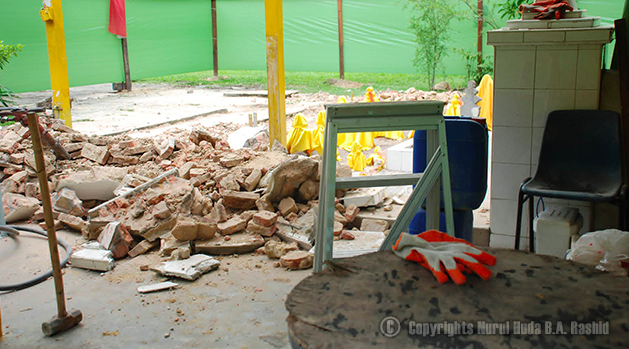
Courtesy of Nurul Huda B.A. Rashid
Mr. Ridhwan, along with Haji Shafie from MUIS was there to partake in the exhumation project. The al-Qadri cemetery was the first to go on 11th January 2010, and no kin came to claim the grave. Near completion of the project, someone showed up to claim the graves, but he unable to provide any relevant documents such as genealogy record or death certificate, aside from the name al-Qadri printed on his identity card.
When exhumation of al-Qadri graves completed, next was al-Aydrus cemetery. The project temporarily halted at this point, because Wak Ali has yet to find a place to stay. On 21st September 2010, after his valuable’s moves to his nephew’s house at Kampung Arang, only then the project resumed.
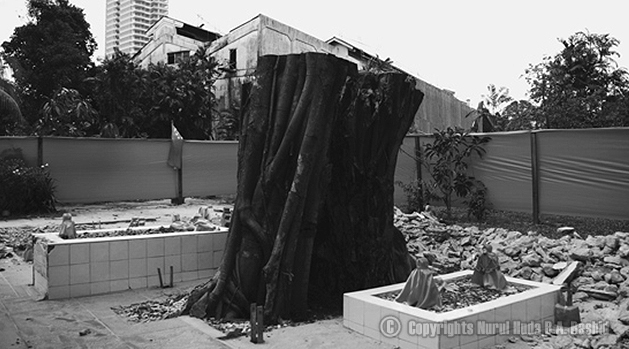
Courtesy of Nurul Huda B.A. Rashid
A rumor sprouted that the halt was because of the two accidents occurred during the exhumation at al-Aydrus cemetery. The first accident was about a contractor. Described that he’s up on an old tree as a ‘look out’, one has to wonder what he’s looking out for – incoming enemy forces? The contractor, without any substantial reason for being up a tree, and without practicing safety procedures, slipped and fell. He still lives. The second involved a road accident between two buses, at Geylang Road, opposite Lorong 1 bus terminal. Road accidents could happen at any time.
As contractors, they should know that accidents are preventable and avoidable when one practice safety measures. Instead, they started gossiping with vague assumptions before resuming the project. Indeed, the project halted, but for about an hour.
Mysterious graves at Chua Chu Kang
In the same Berita Harian article, the numbers of exhumed graves counted as 60.
According to the original numbers of graves at Keramat Kallang, 23 were from al-Qadri cemetery and 22 were from al-Aydrus cemetery. Therefore, total number of graves exhumed on 11th January 2010 and 21st September 2010 were 42. At Chua Chu Kang cemetery, it was discovered that there were 30 al-Qadri, and 32 al-Aydrus. Al-Qadri has seven extra graves and 10 for al-Aydrus.
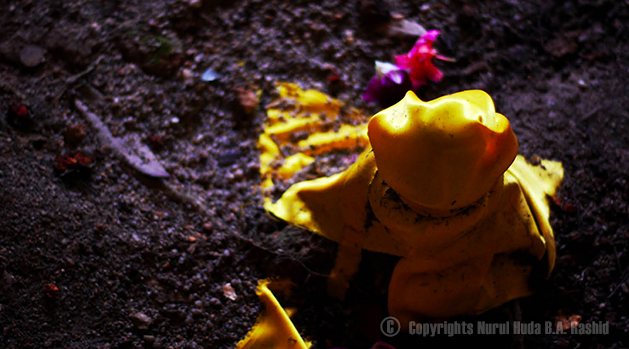
Courtesy of Nurul Huda B.A. Rashid
The total for Chua Chu Kang cemetery is 62, which does not equate what’s written in Berita Harian. Both numbers completely does not equate what originally found Kermat Kallang, between 1987 and 21st September 2010.
The issue was that almost all graves exhumed from Keramat Kallang were without names inscribed to the tombstones, excluding the keramats. Because no person, with relevant documentation, claim the remains (or what’s left), nameless grave remained unidentified.
It was less likely there’s any miscount during the project. Something must have happened after the new plots were created at Chua Chu Kang cemetery. The question is, what?
Notes
- Before publication, Mr. Ridhwan assisted and reviewed with the contexts made to this report. He was Wak Ali’s friend and assistant for Keramat Kallang. Since the age of 12, he humbly devoted himself to studying, maintaining and involving site projects like Radin Mas, Habib Noh and Sharifah Rogayah. His focus is not only in Singapore, but also tomb sites in neighboring countries. He’s involved in the Keramat Kallang exhumation on 11th January 2010 and 21st September 2010. Mr. Ridhwan also assisted Urban Explorers of Singapore in the past, successfully debunk few enigmatic rumors such as the mystery of Siti Zubaidah’s tomb in the Shang Lim Monastery and the mystery of Radin Mas tomb located at Mt. Faber. As Mr. Ridhwan has placed much effort with this report, we solely dedicated this entry to him.
- Some/None/All photos used in entry are captioned according to their owner. Those without caption were either belong to Urban Explorers of Singapore or random, but pretty photo, found on Google Image.
References
- "A relatively new keramat is under a tree within the compound of the People's Association in the former Kallang Airport grounds behind the Firestone factory. It is one of a handful of graves sited just inside the main gate of the old airport. 'Surprisingly, the land office allowed a shed to be constructed and the keramat to remain to this day.' There were formerly several reputed keramat among isolated graves and old cemeteries in this area" - Rivers, P. 2003. Keramat in Singapore in the mid-twentieth century. Journal of the Malaysian Branch of the Royal Asiatic Society, pp. 93--119.
- "Pelembang's significance as a port probably dates back to prehistoric period when the metal culture of the mainland was spread about by the Malay sailors from the more easterly island" - Tarling, N. 1992. The Cambridge history of Southeast Asia. Cambridge, UK: Cambridge University Press. p. 198
- "Pontianak had only recently been founded, on 23 October 1771, by the son of an Arab immigrant. The first Alkadri, Syarif Abdulrahman (r. 1771-1808), and his son and successor, Syarif Kassim (r. 1908-1819) utilized the trapping of Malay sultanates but put their own imprint on Malay statecraft, and they use, in a way few of their peers could, their personal relations with Westerners to both manipulate them and to hold them at a distance." - Heidhues, M. 1998. The First Two Sultans of Pontianak. 56 (1), pp. 273-294. Available from: doi: 10.3406/arch.1998.3491.
- Ismail, S. 1987. Kg Kallang tiada lagi, penduduk sering 'kembali'. Berita Harian, 4 October 1987, p. 2.
- Ismail, S. 1987. Usaha minta kekalkan Makam Siti Mariam. Berita Harian, 10 October 1987, p. 3.
- PWD tunda bongkar Makam Siti Mariam. 1987. Berita Harian, 16 December 1987, p. 3.
Comments
 Forgotten places, secret spots, historical sites or some interesting information to share? Don't tell us. Let us guess and we'll post it up. But if you have something to say about to this topic? Fire it up! ...and don't forget to SHARE this post. You share, we treat you makan next if we meet. *bribe* ;).
Forgotten places, secret spots, historical sites or some interesting information to share? Don't tell us. Let us guess and we'll post it up. But if you have something to say about to this topic? Fire it up! ...and don't forget to SHARE this post. You share, we treat you makan next if we meet. *bribe* ;).






















